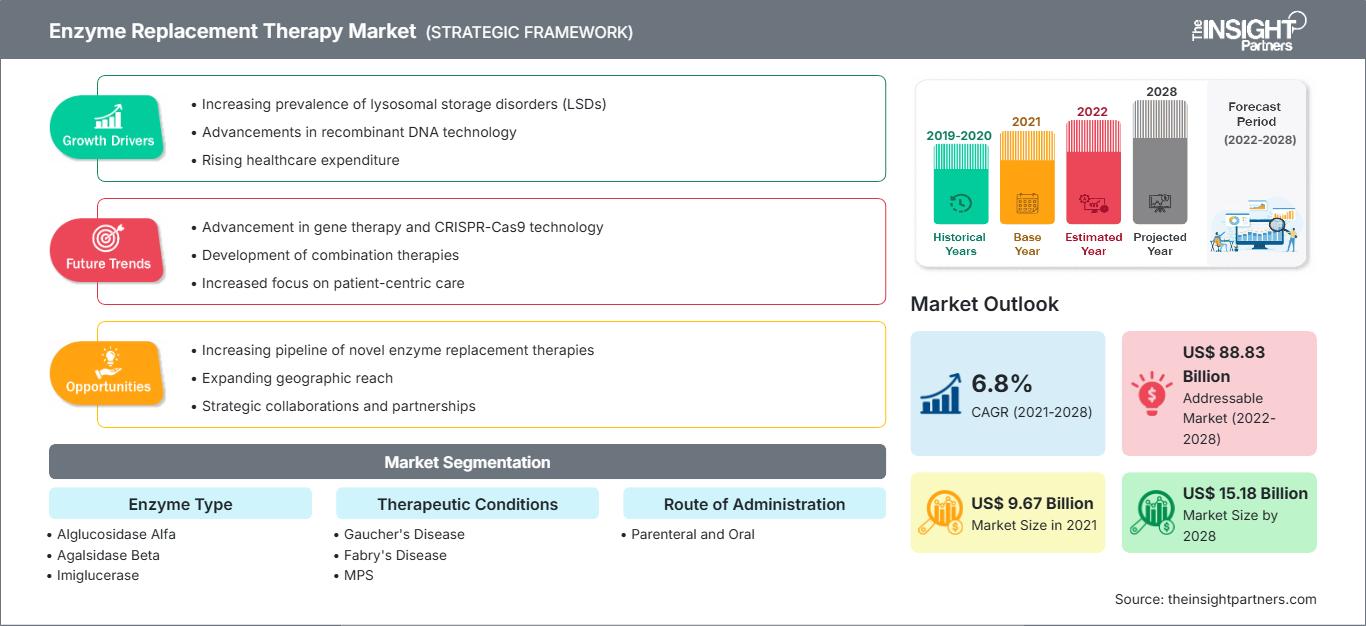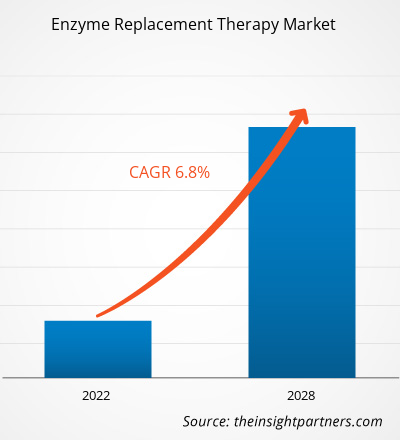Si prevede che il mercato della terapia enzimatica sostitutiva crescerà da 9.673,39 milioni di dollari nel 2021 a 15.184,70 milioni di dollari entro il 2028; si stima una crescita a un CAGR del 6,8% dal 2022 al 2028.
La terapia enzimatica sostitutiva (ERT) viene eseguita per trattare le carenze enzimatiche congenite utilizzando enzimi o proteine con attività enzimatica. Enzimi animali, umani e ricombinanti ingegnerizzati sono alcune delle fonti di enzimi necessari per il trattamento. La terapia è generalmente applicata in malattie rare e da accumulo lisosomiale, tra cui la malattia di Pompe, la malattia di Fabry, la malattia di Gaucher, la malattia di Tay-Sachs e la sindrome di Hurler. Il metodo ERT più comune è l'infusione endovenosa, in cui l'enzima sostitutivo viene somministrato direttamente nel flusso sanguigno attraverso una flebo controllata di liquidi. La crescita del mercato globale della terapia enzimatica sostitutiva è attribuita alla crescente prevalenza delle malattie da accumulo lisosomiale (LSD) e alla rapida approvazione normativa, con altri vantaggi per la commercializzazione dei farmaci con designazione di farmaco orfano. Tuttavia, la spietata concorrenza tra gli operatori del mercato ostacola la crescita del mercato.
Il rapporto offre approfondimenti e analisi approfondite del mercato globale della terapia enzimatica sostitutiva, evidenziando diversi parametri, tra cui tendenze di mercato, progressi tecnologici, dinamiche di mercato e analisi del panorama competitivo dei principali operatori di mercato a livello globale. Include anche l'impatto della pandemia di COVID-19 sul mercato in tutte le regioni. A causa della pandemia di COVID-19, molte autorità sanitarie si sono concentrate sull'assistenza correlata alla pandemia. Inoltre, molti pazienti che necessitavano di terapia enzimatica sostitutiva hanno saltato le infusioni a marzo 2020 a causa dell'inadeguatezza dei servizi ospedalieri per gestire il carico di pazienti affetti da COVID-19. I pazienti che necessitavano di ERT hanno affermato di sentirsi ansiosi durante i ricoveri ospedalieri o in merito alla fornitura di farmaci. Inoltre, gli studi hanno rivelato che alcuni pazienti soffrivano di depressione e di un aumento dell'ansia. Pertanto, le sedute programmate di terapia enzimatica sostitutiva (ERT) sono state interrotte durante la pandemia di COVID-19, con un impatto negativo sul mercato.
Personalizza questo rapporto in base alle tue esigenze
Potrai personalizzare gratuitamente qualsiasi rapporto, comprese parti di questo rapporto, o analisi a livello di paese, pacchetto dati Excel, oltre a usufruire di grandi offerte e sconti per start-up e università
Mercato della terapia enzimatica sostitutiva: Approfondimenti strategici

-
Ottieni le principali tendenze chiave del mercato di questo rapporto.Questo campione GRATUITO includerà l'analisi dei dati, che vanno dalle tendenze di mercato alle stime e alle previsioni.
Approfondimenti basati sulla geografia
In base alla geografia, il mercato globale della terapia enzimatica sostitutiva è segmentato in Nord America (Stati Uniti, Canada e Messico), Europa (Francia, Germania, Regno Unito, Spagna, Italia e resto d'Europa), Asia Pacifico (Cina, India, Giappone, Australia, Corea del Sud e resto dell'APAC), Medio Oriente e Africa (Arabia Saudita, Emirati Arabi Uniti, Sudafrica e resto dell'area MEA) e America meridionale e centrale (Brasile, Argentina e resto dell'America meridionale e centrale).
Approfondimenti di mercato
Crescente prevalenza di malattie da accumulo lisosomiale (LSD)
Un lisosoma è un organello cellulare legato a membrana che contiene enzimi digestivi. Un lisosoma è il fulcro cellulare chiave per il catabolismo, il riciclo e la segnalazione delle macromolecole. Qualsiasi difetto in queste funzioni porta all'accumulo o all'immagazzinamento di macromolecole nei lisosomi, con conseguente danno cellulare. La causa principale delle malattie da accumulo lisosomiale (LSD) sono le mutazioni nei geni responsabili della codifica di un enzima lisosomiale. Inoltre, le LSD sono caratterizzate da un errore metabolico congenito che provoca l'assenza o la carenza di un enzima. Neonati e bambini soffrono più gravemente rispetto agli adulti, poiché i bambini possono ereditare il gene difettoso da uno o entrambi i genitori. Tuttavia, nell'ultimo decennio, il modello è cambiato e le LSD sono più comuni negli adulti.
Inoltre, le LSD sono presenti in circa 70 malattie, tra cui la malattia di Gaucher, la malattia di Niemann-Pick, la malattia di Fabry, la malattia di Tay-Sachs, le mucopolisaccaridosi (MPS) e la malattia di Pompe. Questi disturbi sono rari singolarmente, ma collettivamente sono significativamente diffusi e colpiscono 1 nato vivo su 5.000. Molti Paesi hanno condotto indagini per comprenderne l'andamento della prevalenza, riscontrando un aumento della prevalenza complessiva. Ad esempio, uno studio pubblicato su The Lancet Regional Health intitolato "Prevalenza delle malattie da accumulo lisosomiale in Australia dal 2009 al 2020" ha evidenziato questo fenomeno. Lo studio ha rivelato i seguenti risultati:
- La prevalenza nella popolazione australiana è 1,6 volte (1 ogni 4.800 nati vivi), superiore alla prevalenza riportata nel 1996 (1 ogni 7.700 nati vivi).
- La malattia di Fabry era la più diffusa, rappresentando il 34% di tutte le diagnosi (fino al 2020).
- Le LSD sono più comuni nell'età adulta che nell'infanzia
Pertanto, la crescente prevalenza delle LSD e le terapie limitate per curare la malattia stanno guidando la crescita del mercato globale della terapia enzimatica sostitutiva
Approfondimenti basati sul tipo di enzima
In base al tipo di enzima, il mercato globale della terapia enzimatica sostitutiva è segmentato in alglucosidasi alfa, agalsidasi beta, imiglucerasi, idursulfasi, galsulfasi, velaglucerasi alfa e altri enzimi. Nel 2021, il segmento degli altri enzimi ha rappresentato la quota di mercato maggiore. Si prevede che lo stesso segmento registrerà il CAGR più elevato sul mercato dal 2022 al 2028.
Approfondimenti basati sulle condizioni terapeutiche
In base alle condizioni terapeutiche, il mercato globale della terapia enzimatica sostitutiva è segmentato in malattia di Gaucher, malattia di Fabry, malattia di Pompe, SCID, MPS e altre condizioni terapeutiche. Il segmento della malattia di Gaucher ha detenuto la quota di mercato maggiore nel 2021 e si prevede che registrerà il CAGR più elevato durante il periodo di previsione.
Approfondimenti basati sulla via di somministrazione
In base alla via di somministrazione, il mercato globale della terapia enzimatica sostitutiva è suddiviso in parenterale e orale. Il segmento parenterale ha detenuto una quota di mercato maggiore nel 2021 e si prevede che registrerà un CAGR più elevato durante il periodo di previsione.
Mercato della terapia enzimatica sostitutivaLe tendenze regionali e i fattori che influenzano il mercato della terapia enzimatica sostitutiva durante il periodo di previsione sono stati ampiamente spiegati dagli analisti di The Insight Partners. Questa sezione illustra anche i segmenti e la geografia del mercato della terapia enzimatica sostitutiva in Nord America, Europa, Asia-Pacifico, Medio Oriente e Africa, America meridionale e centrale.
Ambito del rapporto di mercato sulla terapia enzimatica sostitutiva
| Attributo del rapporto | Dettagli |
|---|---|
| Dimensioni del mercato in 2021 | US$ 9.67 Billion |
| Dimensioni del mercato per 2028 | US$ 15.18 Billion |
| CAGR globale (2021 - 2028) | 6.8% |
| Dati storici | 2019-2020 |
| Periodo di previsione | 2022-2028 |
| Segmenti coperti |
By Tipo di enzima
|
| Regioni e paesi coperti |
Nord America
|
| Leader di mercato e profili aziendali chiave |
|
Densità degli operatori del mercato della terapia enzimatica sostitutiva: comprendere il suo impatto sulle dinamiche aziendali
Il mercato della terapia enzimatica sostitutiva è in rapida crescita, trainato dalla crescente domanda degli utenti finali, dovuta a fattori quali l'evoluzione delle preferenze dei consumatori, i progressi tecnologici e una maggiore consapevolezza dei benefici del prodotto. Con l'aumento della domanda, le aziende stanno ampliando la propria offerta, innovando per soddisfare le esigenze dei consumatori e sfruttando le tendenze emergenti, alimentando ulteriormente la crescita del mercato.

- Ottieni il Mercato della terapia enzimatica sostitutiva Panoramica dei principali attori chiave
Approfondimenti basati sull'utente finale
In base all'utente finale, il mercato globale della terapia enzimatica sostitutiva è segmentato in ospedali, centri infusionali e altri. Il segmento ospedaliero ha detenuto la quota di mercato maggiore nel 2021. Tuttavia, si prevede che il segmento dei centri infusionali registrerà il CAGR più elevato durante il periodo di previsione.
Gli operatori del mercato globale della terapia enzimatica sostitutiva adottano strategie organiche, tra cui il lancio e l'espansione di prodotti, per espandere la propria presenza e il portafoglio prodotti a livello mondiale e soddisfare la crescente domanda. Alcuni dei principali operatori che contribuiscono al mercato sono Takeda Pharmaceutical Company Limited; Sanofi SA; AbbVie Inc.; BioMarin Pharmaceutical Inc.; Amicus Therapeutics; Alexion Pharmaceuticals, Inc. (AstraZeneca); Janssen Pharmaceuticals (Johnson & Johnson Services, Inc.); Recordati SpA; Pfizer Inc.; e CHIESI Farmaceutici SpA
- Analisi storica (2 anni), anno base, previsione (7 anni) con CAGR
- Analisi PEST e SWOT
- Valore/volume delle dimensioni del mercato - Globale, Regionale, Nazionale
- Industria e panorama competitivo
- Set di dati Excel
Report recenti
Testimonianze
Motivo dell'acquisto
- Processo decisionale informato
- Comprensione delle dinamiche di mercato
- Analisi competitiva
- Analisi dei clienti
- Previsioni di mercato
- Mitigazione del rischio
- Pianificazione strategica
- Giustificazione degli investimenti
- Identificazione dei mercati emergenti
- Miglioramento delle strategie di marketing
- Aumento dell'efficienza operativa
- Allineamento alle tendenze normative






















 Ottieni un campione gratuito per - Mercato della terapia enzimatica sostitutiva
Ottieni un campione gratuito per - Mercato della terapia enzimatica sostitutiva